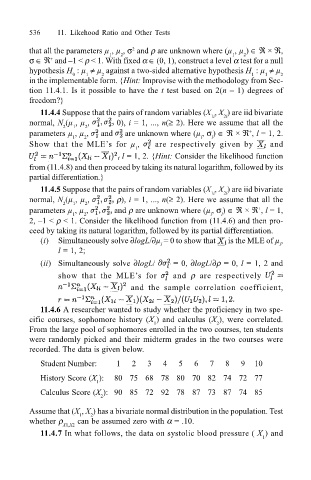Page 559 - Probability and Statistical Inference
P. 559
536 11. Likehood Ratio and Other Tests
2
that all the parameters µ , µ , σ and ρ are unknown where (µ , µ ) ∈ ℜ × ℜ,
2
1
2
1
σ ∈ ℜ and 1 < ρ < 1. With fixed α ∈ (0, 1), construct a level α test for a null
+
hypothesis H : µ ≠ µ against a two-sided alternative hypothesis H : µ ≠ µ 2
1
1
0
1
2
in the implementable form. {Hint: Improvise with the methodology from Sec-
tion 11.4.1. Is it possible to have the t test based on 2(n 1) degrees of
freedom?}
11.4.4 Suppose that the pairs of random variables (X , X ) are iid bivariate
1i
2i
normal, N (µ , µ , 0), i = 1, ..., n(≥ 2). Here we assume that all the
2 1 2
+
parameters µ , µ , and are unknown where (µ , σ ) ∈ ℜ × ℜ , l = 1, 2.
l
1
l
2
Show that the MLEs for µ , are respectively given by and
l
l = 1, 2. {Hint: Consider the likelihood function
from (11.4.8) and then proceed by taking its natural logarithm, followed by its
partial differentiation.}
11.4.5 Suppose that the pairs of random variables (X , X ) are iid bivariate
2i
1i
normal, N (µ , µ , ρ), i = 1, ..., n(≥ 2). Here we assume that all the
1
2
2
parameters µ , µ , and ρ are unknown where (µ , σ ) ∈ ℜ × ℜ , l = 1,
+
1 2 l l
2, 1 < ρ < 1. Consider the likelihood function from (11.4.6) and then pro-
ceed by taking its natural logarithm, followed by its partial differentiation.
(i) Simultaneously solve ∂logL/∂µ = 0 to show that is the MLE of µ , l
l
l = 1, 2;
(ii) Simultaneously solve ∂logL/ = 0, ∂logL/∂ρ = 0, l = 1, 2 and
show that the MLEs for and ρ are respectively
and the sample correlation coefficient,
11.4.6 A researcher wanted to study whether the proficiency in two spe-
cific courses, sophomore history (X ) and calculus (X ), were correlated.
2
1
From the large pool of sophomores enrolled in the two courses, ten students
were randomly picked and their midterm grades in the two courses were
recorded. The data is given below.
Student Number: 1 2 3 4 5 6 7 8 9 10
History Score (X ): 80 75 68 78 80 70 82 74 72 77
1
Calculus Score (X ): 90 85 72 92 78 87 73 87 74 85
2
Assume that (X , X ) has a bivariate normal distribution in the population. Test
2
1
whether ρ can be assumed zero with α = .10.
X1,X2
11.4.7 In what follows, the data on systolic blood pressure ( X ) and
1

